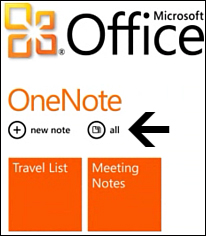Synchronizing Your Notes with SkyDrive
When you first begin to use OneNote Mobile on your Windows Phone 7, it creates your notes on the phone.
To synchronize your default notebook on Windows Live SkyDrive for the first time, do the following:
1. | On the Office home screen, tap All (see Figure 2).

|
2. | At the bottom of the screen, tap the round Refresh icon.
|
3. | When the Sync with SkyDrive? prompt appears, tap Yes.
|
4. | Watch
the very top of your screen for status messages. When OneNote has
finished signing in and synchronizing your account, a personal notebook
named “Personal (Web)” will be created in your My Documents folder on
SkyDrive. Notes you create or edit here will be automatically
synchronized with SkyDrive.
|
To view the contents of your
“Personal (Web)” notebook on SkyDrive, tap All on the Office home screen
and then, at the top of the screen, tap Notebooks.
To open any page in your
“Personal (Web)” notebook, tap the notebook in the Notebooks list and
then tap the page you want to open. Any changes you make to the page
will be automatically synchronized with your SkyDrive account.
|
If you don’t want your
mobile notes to be automatically synchronized with your SkyDrive account
for some reason, you can turn this option off. On the Office home
screen, tap All, and then tap the More (...) icon. On the menu that
appears, tap Settings. Tap the Automatic Sync switch from On to Off.
|
You should never rename or
delete the “Personal (Web)” notebook or the Unfiled Notes section within
it while a sync relationship between your Windows Phone 7 and SkyDrive
exists. Doing so may result in the loss of some of your notes.
If you want to open a different OneNote notebook that you’ve stored on SkyDrive, do the following:
1. | On your Windows Phone 7 device, tap the Internet Explorer icon on your phone’s Home screen.
|
2. | At the bottom of the screen, tap the More (...) icon and then tap Settings.
|
3. | On the Settings page, under Website Preference, make sure the Mobile Version option is selected (tap it, if necessary).
|
4. | Tap the Back button at the bottom of your phone or device to return to the previous screen.
|
5. | Tap the Address bar in Internet Explorer, type http://office.live.com, and then tap the Go button (the right-facing arrow on the onscreen keyboard).
|
6. | On the Windows Live sign-in screen, enter your Windows Live ID and password and then tap Sign In.
|
7. | In your folder list, tap the folder containing the notebook you want to open and then tap the name of the notebook.
|
8. | When
the notebook properties are displayed, tap the big OneNote icon to open
the notebook and then tap any page to view or edit its notes.
|
Searching Your Notes
OneNote’s wonderful
Instant Search feature that you’ve likely come to appreciate in the full
version of OneNote 2010 is also available on Windows Phone 7.
To find specific text in any of your notes pages, do the following:
1. | On the Office home screen, tap All (see Figure 11.3).
|
2. | While in the Pages list, tap the Search button at the bottom of your phone or device.
|
3. | In the Search box that appears at the top of the page, type a word or phrase for which to search your notes.
|
4. | Tap any of the pages that appear in the results list to go to the note containing the occurrence.
|
To cancel searching without going to a note, tap the Back button at the bottom of your phone or device.
Deleting Notes
To erase notes you no longer need, do the following:
1. | On the Office home screen, tap All (see Figure 2).
|
2. | In the Pages list, tap and hold the title of the page you want to delete.
|
3. | When the pop-up menu appears, tap Delete.
|
4. | When the confirmation prompt appears, tap Yes to delete the note.
|
|
Deleting pages on your
phone permanently destroys the information they contain. You cannot undo
page deletions, so be sure not to rush through the deletion steps.
|
Checking for Updates
OneNote Mobile is part of Office Mobile, which is installed and updated as part of the Windows Phone 7 operating system.
To make sure you’re alerted of occasional software updates, do the following:
1. | Near
the upper right on your phone’s Start screen, click the circled arrow
pointing to the right. Alternately, you can swipe your finger across the
screen from the right side to the left.
|
2. | In the list that appears, scroll down and then tap Settings.
|
3. | On the Settings screen, scroll down and then tap Phone Update.
|
4. | If necessary, tap the check boxes here to enable the update notification option.
|
5. | Tap the Start (Windows logo) key at the bottom of your phone or device to save your settings.
|
If you’re notified of updates
to your Windows Phone 7 operating system (which might or might not
include functionality changes and updates for Office Mobile), connect
your phone or device to the Windows Phone 7 software installed on your
computer and follow the upgrade prompts.